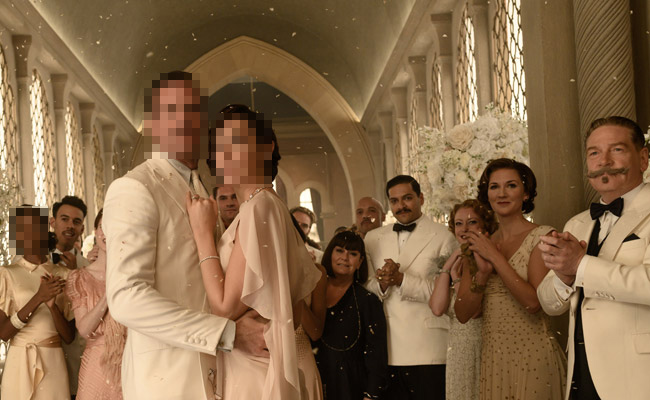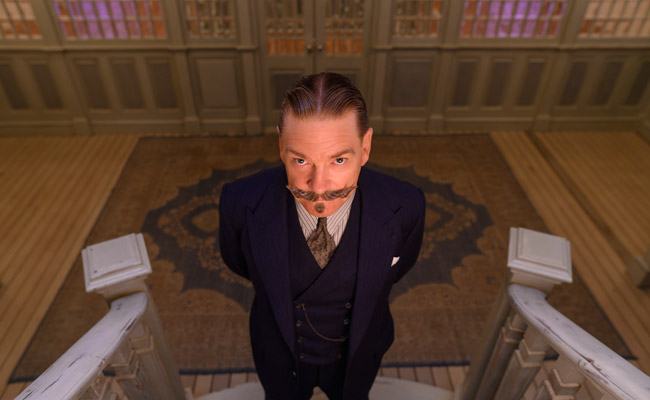
20th Century Studios
It’s been almost a year since I reviewed the then new Blu-ray release of the classic 1978 murder mystery Death on the Nile, and it’s been almost a year and a half since the remake was due in theaters, missing its October 2020 release date due to the pandemic and suddenly problematic cast members (ahem, Armie Hammer). And since that time, a few more of the cast have become a bit problematic as well, so we have to put all of this information behind us and view the film through the lens of last 2020. It’s also hard to believe it’s been five years since the release of Murder on the Orient Express, the conclusion of which hinted in the film’s closing scene that this film was coming (if Orient Express was a success, which it was).
Death on the Nile has been filmed before, as noted above, and that film took a slightly lighter approach to an all-star murder mystery than did its predecessor, 1974’s Murder on the Orient Express. That film was notable for the introduction of Peter Ustinov as Hercule Poirot, catty dialogue from Bette Davis and Maggie Smith, and an over-the-top performance from Angela Lansbury. The new version of the film leaves much of the humor out of the script — even with comedy duo French & Saunders taking on the Davis & Smith roles — and gives us a more straightforward and gripping mystery drama. As with the original, young Jacqueline de Bellefort (Emma Mackey) introduces her rich best friend Linnet Ridgeway (Gal Gadot) to her fiance Simon Doyle (Armie Hammer), and before you know it the happy couple is honeymooning in Egypt … except the couple are Simon and Linnet, now being tailed all around the globe by the disgruntled Jackie. Thinking they can escape the woman by boarding a steamer up the Nile, and hoping some intervention from Poirot will convince her to move on with her life, they and their wedding guests are surprised to find Jackie on board after a stop which almost left Simon and Linnet crushed by a falling rock at an Egyptian temple. Jackie, of course, is the prime suspect but she was already aboard the Karnak at the time of the accident. But was it an accident, or is there another passenger who has it out for the socialite? All of the guests, naturally, know Linnet and they all have a beef with her. Tensions flare between Jackie and Simon, leaving her former beau with a bullet in his leg and Jackie heavily sedated, but the next morning it is Linnet who is dead, shot in the temple. With both Jackie and Simon having solid alibis, who could have committed the crime? Linnet’s godmother? Her former beau? Poirot’s friend Bouc? The hired singer or her niece? It is a puzzle that only the great Hercule Poirot can solve.
If you’re a fan of the 1978 film, you won’t be surprised by the reveal of Linnet’s killer or killers (no spoilers here). But there are enough subtle, and not so subtle, changes to keep the film fresh for those already familiar with the story. Probably the biggest change is the character of Salome Otterbourne, played by Lansbury in the original and by Sophie Okonedo here. In the original film and novel, Salome was a torrid romance novelist and here she is a blues/jazz musician, with her niece and assistant Rosalie played by Letitia Wright. Their entire storyline is also much different from the original, with Rosalie in a secret romance with Bouc, who is not in the original story at all but rather a carry over from Orient Express to further tie the two films together. The doctor in the original, played by Jack Warden, is now a doctor and ex of Linnet’s played by Russell Brand. Bouc’s mother Euphemia (Annette Bening) is also a new addition to the story. One of these characters also dies in the original film but has a different fate here. So, there is quite a bit different to keep those already familiar with the story and the film on their toes.

20th Century Studios
Death on the Nile also works a bit better than Murder on the Orient Express which suffered from a huge cast of stars in what amounted to cameos with only two or three of them getting any substantial screen time. Here director Kenneth Branagh remedies that situation by giving all of the cast their moments to shine, and as they are on a smaller vessel than a train, more of them are used in scenes as background characters as well. It’s all much more finely balanced than Orient Express. I would say the only cast member who gets relegated to ‘cameo’ status is Rose Leslie as Linette’s assistant Louise Bourget. That character was much more prominent in the original, and her similar fate in this film doesn’t have the same impact as we never really got to know her. In addition to directing, Branagh also returns as Poirot, and just like James Bond, you’re either going to love him or hate him (everyone seems to have their favorite Poirot). One of the most universal criticisms of Branagh’s Poirot is his signature mustache, which has always been depicted as waxed and curled up on the ends. Brangh’s massive ‘stache is often distracting from the story, particularly as he favors a lot of close-ups so you can’t help but stare at it. But, in another new addition to the story, Branagh actually gives the facial hair its own interesting backstory which opens the film and ends with quite a surprise that many may consider sacrilegious when it comes to that mustache. It will be very interesting to see how Branagh carries on should there be another film in the series (originally Death on the Nile was followed cinematically by Evil Under the Sun and The Mirror Crack’d).
What I also enjoyed about the film aside from the story, the cast and the production design with its often over-saturated colors, is Branagh’s directing, which some may consider a bit stodgy or stilted. If you hold the two films up side-by-side, you’d see the pacing is pretty much the same. The problem with audiences today is that we’ve been conditioned to view films with shots that last barely longer than six seconds. Branagh allows us to soak in characters walking along the length of the Karnak’s upper deck and down the stairs on the outside to the lower deck. He uses long, wider shots to show everyone in a particular space on the boat, cutting to close-ups with a lot of dialogue but never rushing things. It’s a nice throwback to a bygone era and I enjoyed the languorous feel to it all. This is a film with a story that you want to sit back and soak in. It doesn’t require or need frenetic editing to keep our interest.
Over all, I enjoyed Death on the Nile even more than Murder on the Orient Express even though I was very familiar with how it was all going to end. With great performances and enough tweaks to make it fresh, not to mention the whole mustache backstory which also helped humanize Poirot a bit, this is a voyage I would not mind taking again.
Death on the Nile has a run time of 2 hours 7 minutes and is rated PG-13 for violence, some bloody images, and sexual material.
